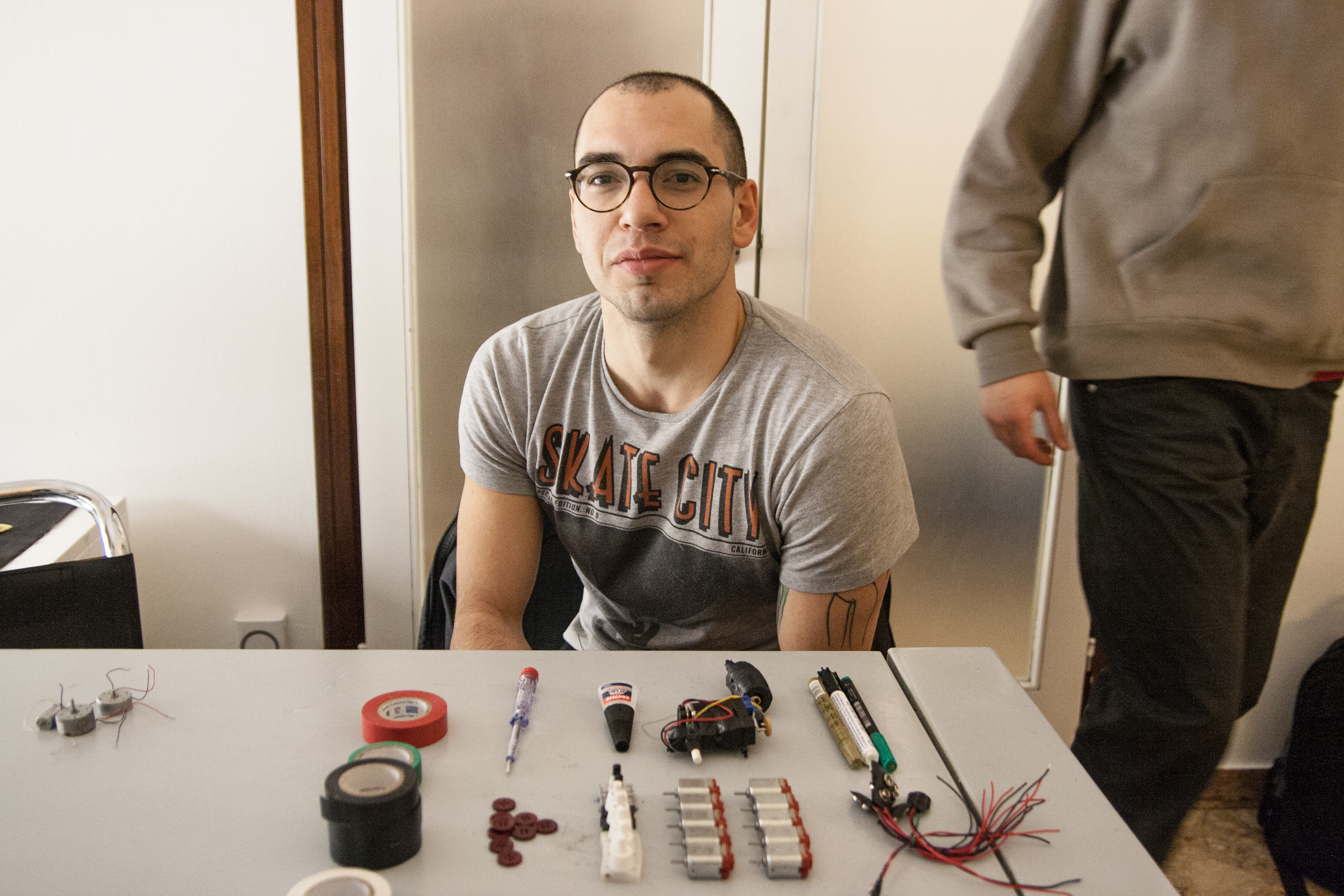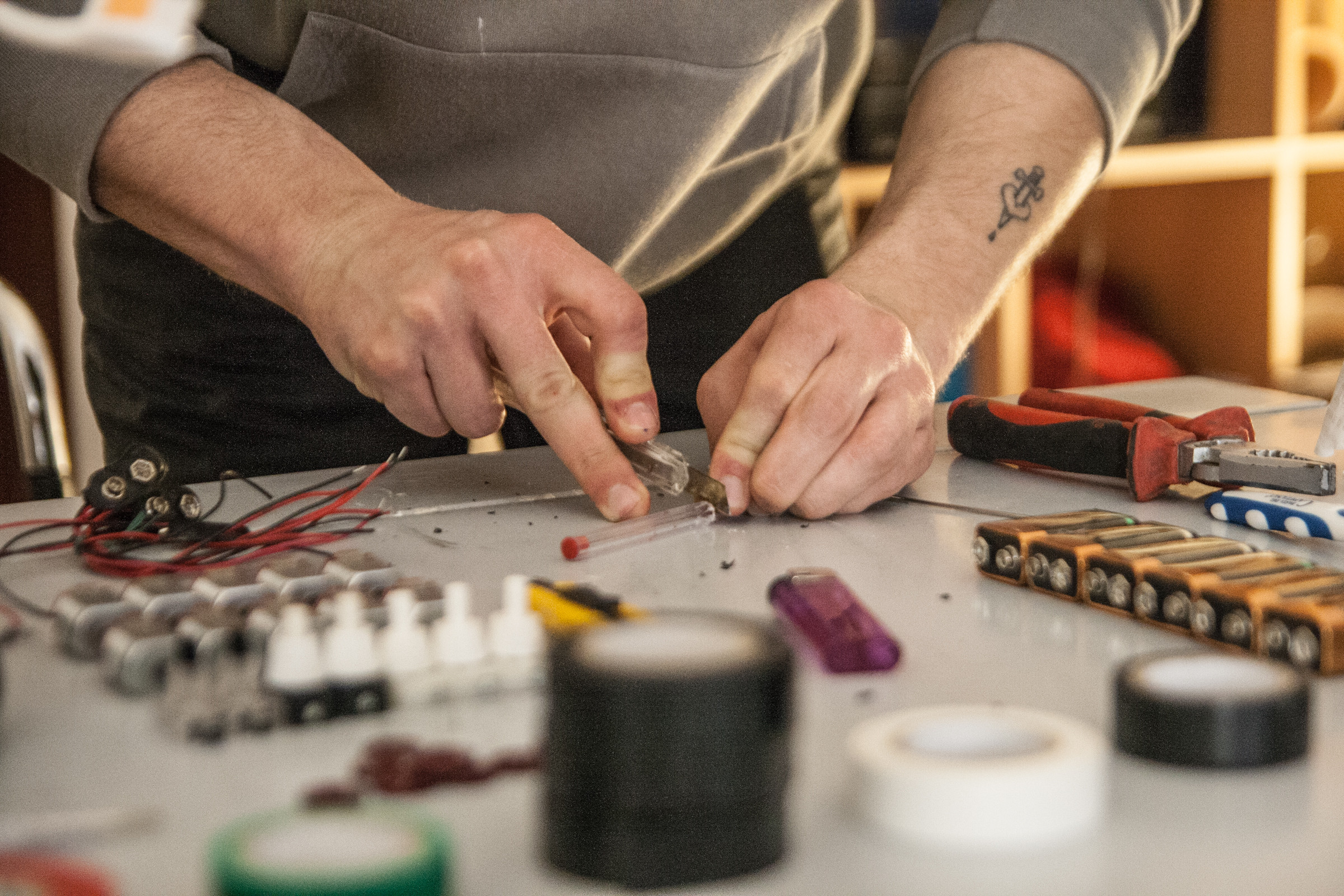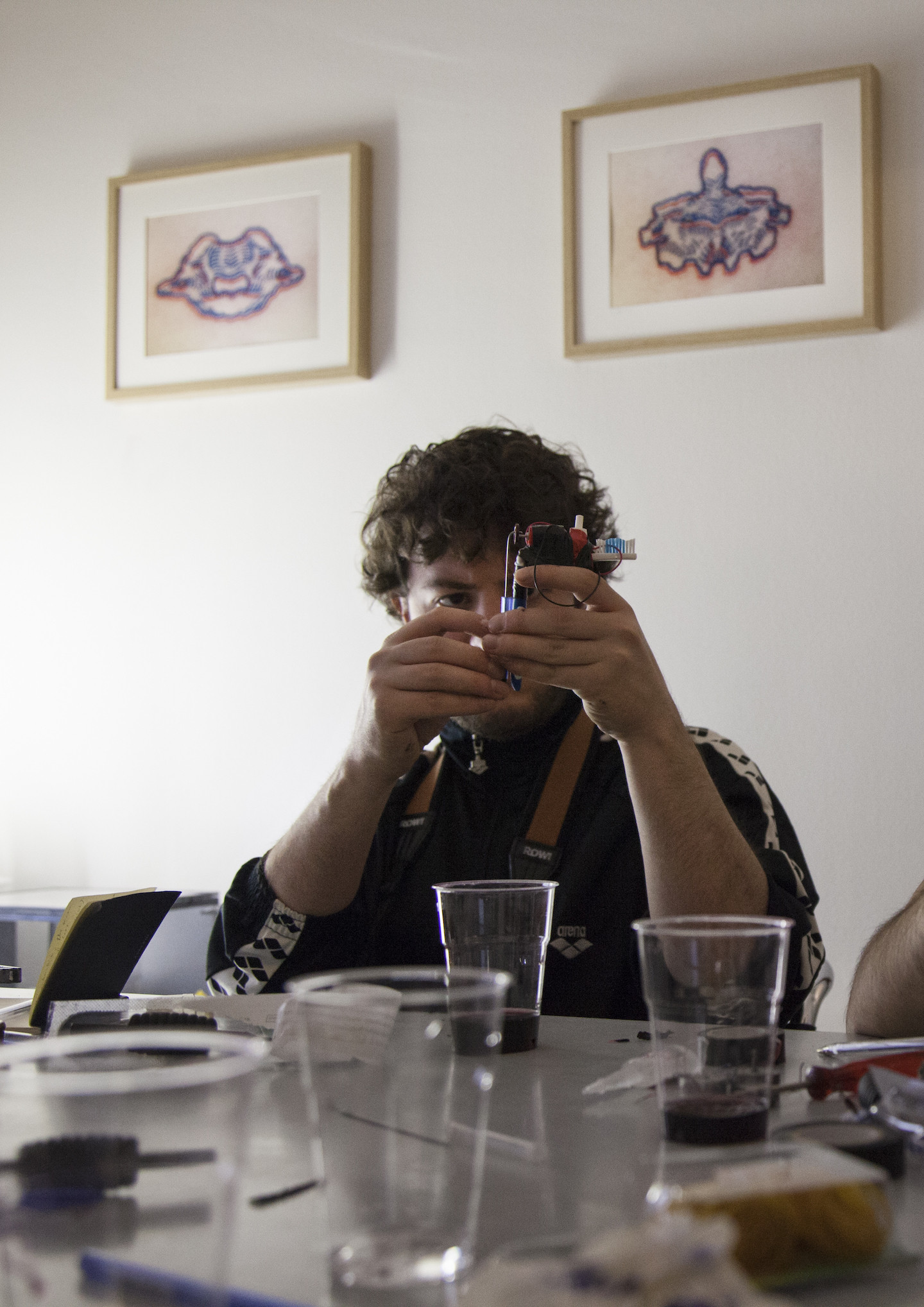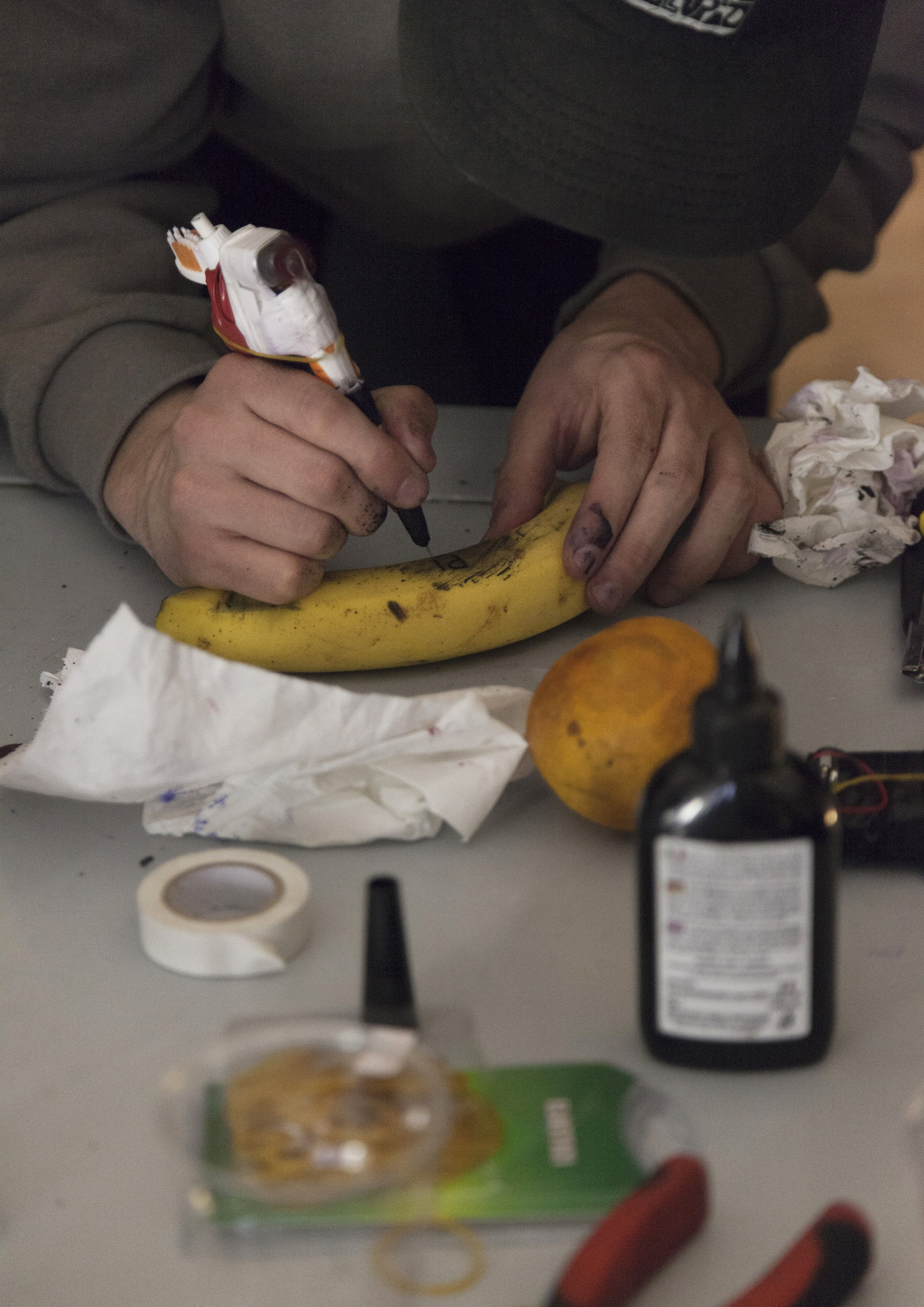Are you fascinated by the art of tattooing and curious about the mechanics behind it? Making a tattoo machine at home can be an intriguing project. At tattooat.com, we’ll guide you through the process, while emphasizing the importance of safety, hygiene, and responsible tattooing practices. This guide will provide detailed instructions and essential considerations for creating your own tattoo device.
1. What Are The Basic Components Of A Tattoo Machine?
The basic components of a tattoo machine are the frame, motor, needle bar, needles, and power supply. The frame provides structure, the motor powers the needle movement, the needle bar holds the needles, and the power supply provides electricity. Understanding these parts is crucial when considering how to create a DIY tattoo machine, though we strongly recommend using professional equipment for actual tattooing.
1.1 What Is The Function Of The Frame In A Tattoo Machine?
The frame of a tattoo machine is the backbone, providing stability and structure. It houses all other components and maintains precise alignment, crucial for accurate tattooing. Typically crafted from metal, the frame’s design affects the machine’s balance, weight distribution, and vibration, thus impacting the artist’s control and comfort.
1.2 How Does The Motor Work In A Tattoo Machine?
The motor is the heart of the tattoo machine, converting electrical energy into mechanical motion. This motion drives the needle bar up and down, enabling the needles to puncture the skin and deposit ink. Motors vary in speed (measured in hertz or cycles per second) and power, influencing the machine’s suitability for different tattooing styles.
1.3 What Is The Purpose Of The Needle Bar In A Tattoo Machine?
The needle bar is a slender metal rod that holds the tattoo needles securely. Connected to the motor, it translates the motor’s rotary motion into a linear, reciprocating movement. This up-and-down motion is what drives the needles in and out of the skin. Precision in the needle bar’s construction and alignment is crucial for consistent ink delivery.
1.4 Why Are Needles Important In A Tattoo Machine?
Tattoo needles are responsible for the precise delivery of ink into the skin’s dermis layer. They come in various configurations (e.g., liners for outlines, shaders for filling) and sizes, each suited to different tattoo styles and effects. Sterility is paramount; single-use, pre-sterilized needles are essential to prevent infections and cross-contamination.
1.5 How Does The Power Supply Affect The Tattoo Machine’s Performance?
The power supply provides a stable and adjustable electrical current to the tattoo machine’s motor. It allows tattoo artists to control the machine’s speed and power, adapting to different skin types, tattoo designs, and personal preferences. A reliable power supply ensures consistent performance, minimizing fluctuations that could affect the tattoo’s quality.
2. What Tools And Materials Are Needed To Build A Simple Tattoo Machine At Home?
To build a simple tattoo machine at home, gather these tools and materials: a small DC motor, a pen casing, a needle, a toothbrush, electrical tape, wires, a power source (like a battery), and some basic tools like pliers and a lighter. Remember, this is for educational purposes only; actual tattooing requires professional equipment and sterile conditions.
2.1 How Do You Choose The Right DC Motor For A DIY Tattoo Machine?
Choosing the right DC motor involves considering voltage, speed (RPM), and torque. A low-voltage motor (3-6V) is safer for DIY projects. Look for a motor with moderate speed for controlled needle movement. Ensure it has enough torque to drive the needle without stalling.
2.2 What Type Of Pen Casing Works Best For A Homemade Tattoo Machine?
A sturdy, cylindrical pen casing works best. It should be easy to grip and able to house the motor and needle mechanism securely. The casing should also allow for smooth needle movement without excessive friction.
2.3 Can You Use Regular Needles For A DIY Tattoo Machine, And What Are The Risks?
Using regular needles is highly discouraged due to sterility concerns. Tattoo needles are sterilized and designed for single use to prevent infections. Regular needles cannot be adequately sterilized at home, posing significant health risks.
2.4 How Do You Use A Toothbrush In Building A DIY Tattoo Machine?
A toothbrush handle can serve as the frame for your DIY machine. Its shape provides a comfortable grip, and it can be easily modified to hold the motor and needle assembly. You can heat and bend the plastic for better ergonomics.
2.5 Why Is Electrical Tape Important In Assembling A Homemade Tattoo Machine?
Electrical tape is essential for securing components, insulating wires, and preventing short circuits. It ensures that all parts are firmly attached and that the electrical connections are safe and reliable.
2.6 What Kind Of Power Source Is Safe To Use For A Homemade Tattoo Machine?
A low-voltage battery (e.g., 9V) is the safest power source for a homemade tattoo machine. It provides enough power to run the motor without posing a significant electrical hazard. Avoid using household AC power, as it is dangerous and can cause severe shocks.
2.7 What Basic Tools Are Necessary For Constructing A DIY Tattoo Machine?
Basic tools include pliers for bending wires, a lighter for shaping plastic (use with caution), a screwdriver for tightening screws, and scissors or a knife for cutting materials. These tools help assemble the machine components precisely and safely.
 Tools for homemade tattoo machine including scissors, pliers, batteries, toothbrush, lighter, tape, motor, glue, knife, and screwdrivers
Tools for homemade tattoo machine including scissors, pliers, batteries, toothbrush, lighter, tape, motor, glue, knife, and screwdrivers
3. Step-By-Step Guide: How To Assemble A Simple Tattoo Machine At Home
Assembling a tattoo machine at home involves several steps. First, construct the frame using the toothbrush. Then, attach the motor and create a mechanism for the needle to move up and down. Finally, connect the power source and test the device. Remember, this is for demonstration only; never use homemade machines on skin.
3.1 How Do You Construct The Frame Of A DIY Tattoo Machine Using A Toothbrush?
To construct the frame, heat the toothbrush handle with a lighter (carefully) and bend it to create a comfortable grip. The bent section will serve as the base to which you attach the motor and other components. Ensure the handle is sturdy enough to support the machine.
3.2 How Do You Attach The DC Motor To The Frame Of A Homemade Tattoo Machine?
Secure the DC motor to the frame using electrical tape or glue. Position the motor so that its shaft is aligned with the intended needle path. Ensure the motor is firmly attached to minimize vibrations and ensure smooth needle movement.
3.3 How Do You Create A Mechanism For The Needle To Move Up And Down?
Create a mechanism by attaching a small piece of plastic or metal to the motor shaft. Offset this piece so that as the motor rotates, it pushes and pulls the needle. This can be achieved by bending the needle and securing it to the offset piece.
3.4 How Do You Connect The Power Source To The Motor Of A DIY Tattoo Machine?
Connect the wires from the battery or power source to the motor’s terminals. Use electrical tape to secure the connections and prevent short circuits. Ensure the polarity is correct (positive to positive, negative to negative) for the motor to run in the desired direction.
3.5 What Are The Safety Precautions To Consider When Testing A DIY Tattoo Machine?
When testing, always wear safety glasses to protect your eyes. Ensure the machine is stable and won’t move unexpectedly. Test the machine on a non-organic object like fruit, and never test it on human skin due to the risk of infection.
 Heating the blade made it easier to slice the tube in half
Heating the blade made it easier to slice the tube in half
4. What Are The Risks Associated With Using A Homemade Tattoo Machine?
Using a homemade tattoo machine carries significant risks, including infection, allergic reactions, and inconsistent tattoo quality. Sterility is impossible to achieve at home, and the lack of precision can lead to scarring and unsatisfactory results. Prioritize professional equipment and expertise for safe tattooing.
4.1 Why Is Sterility Impossible To Achieve With A DIY Tattoo Machine?
Achieving sterility requires specialized equipment like autoclaves, which use high-pressure steam to kill all microorganisms. Household cleaning methods are insufficient to eliminate bacteria, viruses, and spores, making DIY machines inherently unsterile.
4.2 What Types Of Infections Can Result From Using Unsterile Tattoo Equipment?
Using unsterile equipment can lead to bacterial infections (e.g., Staphylococcus, Streptococcus), viral infections (e.g., Hepatitis B and C, HIV), and fungal infections. These infections can cause severe health problems, requiring extensive medical treatment.
4.3 How Can A Homemade Tattoo Machine Cause Allergic Reactions?
Allergic reactions can occur due to the use of non-medical grade materials in homemade tattoo machines. These materials may contain allergens that cause skin irritation, rashes, and even severe allergic reactions requiring medical intervention.
4.4 What Are The Potential Consequences Of Inconsistent Tattoo Quality From A DIY Machine?
Inconsistent tattoo quality can result in blurred lines, uneven ink distribution, and scarring. The lack of precision in homemade machines can lead to unsatisfactory aesthetic outcomes and permanent skin damage.
4.5 Can Using A DIY Tattoo Machine Lead To Scarring?
Yes, DIY tattoo machines often lack the precision of professional equipment, leading to excessive trauma to the skin. This can result in the formation of keloids or hypertrophic scars, which are raised, thickened areas of skin.
5. Safe Tattooing Practices: What You Need To Know
Safe tattooing practices include using sterile equipment, following proper hygiene protocols, and obtaining tattoos from licensed professionals. Understanding these practices is crucial for minimizing health risks and ensuring satisfactory results. Always prioritize safety over DIY experimentation when it comes to tattooing.
5.1 Why Is It Important To Use Sterile Equipment For Tattooing?
Using sterile equipment is paramount to prevent the transmission of bloodborne pathogens and other infections. Sterile needles and equipment ensure that no harmful microorganisms enter the skin during the tattooing process, minimizing the risk of complications.
5.2 What Hygiene Protocols Should Be Followed During Tattooing?
Hygiene protocols include washing hands thoroughly, wearing gloves, disinfecting the skin, and using single-use disposable equipment. These practices create a barrier against infection and maintain a clean working environment.
5.3 How Do You Properly Disinfect The Skin Before Tattooing?
Proper skin disinfection involves cleaning the area with an antiseptic solution like isopropyl alcohol or chlorhexidine. This reduces the number of microorganisms on the skin’s surface, minimizing the risk of infection when the skin is punctured.
5.4 What Type Of Inks Are Safe To Use For Tattoos?
Safe tattoo inks are those that are specifically formulated for tattooing and have been tested for safety and purity. Avoid using inks that contain heavy metals or other harmful substances, as these can cause allergic reactions and other health problems.
5.5 Why Is It Important To Obtain Tattoos From Licensed Professionals?
Licensed tattoo professionals undergo training in hygiene, sterilization, and safe tattooing practices. They are also regulated by health authorities, ensuring they meet specific standards for safety and quality. Choosing a licensed professional minimizes the risk of complications and ensures a better tattoo experience.
 Maria attaching the sterilised needle to the motor
Maria attaching the sterilised needle to the motor
6. The Importance Of Professional Tattoo Equipment
Professional tattoo equipment is designed for precision, safety, and reliability. Unlike homemade machines, professional equipment meets strict standards for sterilization and performance. Investing in professional equipment is essential for tattoo artists who prioritize the health and satisfaction of their clients.
6.1 What Makes Professional Tattoo Machines Superior To Homemade Ones?
Professional tattoo machines are superior due to their precision, consistent performance, and adherence to safety standards. They are designed to minimize trauma to the skin and ensure accurate ink delivery, resulting in higher-quality tattoos.
6.2 What Are The Key Features Of High-Quality Tattoo Needles?
Key features of high-quality tattoo needles include sharpness, consistent gauge, and proper sterilization. Needles should be made from medical-grade stainless steel and packaged individually to ensure sterility.
6.3 How Does A Professional Tattoo Power Supply Differ From A DIY Setup?
A professional tattoo power supply provides a stable and adjustable voltage, allowing artists to control the machine’s speed and power precisely. DIY setups often lack this level of control, leading to inconsistent performance and potential damage to the machine.
6.4 What Other Equipment Is Essential For A Professional Tattoo Studio?
Essential equipment for a professional tattoo studio includes an autoclave for sterilization, an ultrasonic cleaner for cleaning equipment, disposable gloves, masks, and aprons, as well as medical-grade disinfectants and skin preparation solutions.
6.5 How Does Using Professional Equipment Contribute To Client Safety And Satisfaction?
Using professional equipment demonstrates a commitment to client safety and ensures a higher quality tattoo. Clients are more likely to trust artists who invest in professional equipment, leading to greater satisfaction and positive referrals.
7. Exploring Tattoo Art: Styles And Techniques
Tattoo art encompasses a wide range of styles and techniques, from traditional to modern. Understanding these styles and techniques can enhance your appreciation for the art form and inform your own tattoo choices. Explore the diverse world of tattoo art to find the styles that resonate with you.
7.1 What Are Some Popular Traditional Tattoo Styles?
Popular traditional tattoo styles include Old School (American Traditional), Japanese Traditional (Irezumi), and Tribal. These styles are characterized by bold lines, simple designs, and a limited color palette.
7.2 What Are Some Modern Tattoo Styles Gaining Popularity?
Modern tattoo styles gaining popularity include Realism, Watercolor, Geometric, and Neo-Traditional. These styles showcase intricate details, vibrant colors, and innovative techniques.
7.3 How Do Different Tattoo Techniques Affect The Final Result?
Different tattoo techniques, such as lining, shading, and color packing, affect the final result by creating different visual effects. Lining defines the tattoo’s outline, shading adds depth and dimension, and color packing fills in large areas with solid color.
7.4 What Is The Importance Of Line Work In Tattoo Art?
Line work is crucial in tattoo art as it provides the foundation for the design. Clean, crisp lines create a visually appealing and long-lasting tattoo. Poor line work can result in a blurry or distorted image over time.
7.5 How Does Shading Enhance The Depth And Realism Of A Tattoo?
Shading enhances the depth and realism of a tattoo by creating highlights and shadows. It adds dimension to the design, making it appear more lifelike and three-dimensional.
 Photo courtesy of Homemade Gallery
Photo courtesy of Homemade Gallery
8. Legal And Ethical Considerations In Tattooing
Legal and ethical considerations in tattooing include obtaining informed consent, adhering to age restrictions, and following health regulations. Tattoo artists must operate within the bounds of the law and uphold ethical standards to protect their clients and maintain the integrity of the profession.
8.1 What Is Informed Consent And Why Is It Important In Tattooing?
Informed consent involves providing clients with complete information about the tattoo process, including the risks, aftercare, and potential complications. It ensures that clients make an informed decision and understand the implications of getting a tattoo.
8.2 What Are The Age Restrictions For Getting A Tattoo In The USA?
Age restrictions for getting a tattoo vary by state. In most states, it is illegal to tattoo a minor (under 18) without parental consent. Some states prohibit tattooing minors altogether.
8.3 What Health Regulations Do Tattoo Artists Need To Follow?
Health regulations for tattoo artists include obtaining licenses, undergoing training in hygiene and sterilization, and adhering to specific standards for studio cleanliness and equipment maintenance. These regulations protect public health and minimize the risk of infection.
8.4 What Are Some Ethical Considerations For Tattoo Artists?
Ethical considerations for tattoo artists include respecting client autonomy, maintaining confidentiality, and refusing to perform tattoos that are offensive, hateful, or promote harm. Artists should also be honest about their abilities and limitations.
8.5 How Can Tattoo Artists Ensure They Are Operating Legally And Ethically?
Tattoo artists can ensure they are operating legally and ethically by staying informed about relevant laws and regulations, participating in continuing education, and adhering to a code of ethics established by professional organizations.
9. Tattoo Aftercare: Ensuring The Longevity Of Your Tattoo
Tattoo aftercare is crucial for ensuring the longevity and vibrancy of your tattoo. Proper aftercare involves keeping the tattoo clean, moisturized, and protected from the sun. Follow your tattoo artist’s instructions carefully to promote healing and prevent complications.
9.1 What Are The Immediate Aftercare Steps To Take After Getting A Tattoo?
Immediate aftercare steps include keeping the tattoo covered with a sterile bandage for the first few hours, gently washing the tattoo with mild soap and water, and applying a thin layer of healing ointment.
9.2 How Often Should You Wash A New Tattoo?
A new tattoo should be washed gently with mild soap and water 2-3 times a day. Avoid using harsh soaps or scrubbing the tattoo, as this can irritate the skin and delay healing.
9.3 What Type Of Ointment Is Best For Tattoo Aftercare?
Ointments like Aquaphor or specialized tattoo balms are best for aftercare. These products are designed to keep the tattoo moisturized without clogging pores or causing allergic reactions.
9.4 How Important Is It To Protect A Tattoo From The Sun?
Protecting a tattoo from the sun is crucial, as UV rays can fade the ink and damage the skin. Apply a high-SPF sunscreen to the tattoo whenever it is exposed to sunlight.
9.5 What Are The Signs Of A Tattoo Infection And When Should You Seek Medical Attention?
Signs of a tattoo infection include excessive redness, swelling, pus, fever, and pain. If you experience any of these symptoms, seek medical attention immediately, as infections can lead to serious health problems.
 We tested our tattoo machines on an array of fruit
We tested our tattoo machines on an array of fruit
10. Exploring Tattoo Designs and Inspiration On Tattooat.Com
Looking for tattoo design inspiration? Tattooat.com offers a vast collection of tattoo designs, artist portfolios, and informative articles. Whether you’re seeking a classic design or something unique, tattooat.com is your ultimate resource for all things tattoo-related.
10.1 Where Can You Find Inspiration For Your Next Tattoo Design?
Find inspiration on tattooat.com, where you can browse various styles, themes, and artist portfolios. Social media platforms like Instagram and Pinterest are also great sources of visual inspiration.
10.2 How Do You Choose A Tattoo Design That Reflects Your Personality?
Choose a design that resonates with your interests, values, and personal style. Consider symbols, images, or quotes that hold meaning for you, and collaborate with a tattoo artist to create a custom design that is uniquely yours.
10.3 What Are Some Popular Tattoo Placements And Their Considerations?
Popular tattoo placements include the arm, back, chest, leg, and wrist. Consider factors such as pain tolerance, visibility, and the design’s size and shape when choosing a placement.
10.4 How Do You Find A Reputable Tattoo Artist On Tattooat.Com?
Find reputable artists on tattooat.com by reading reviews, viewing portfolios, and checking their credentials. Look for artists who specialize in the style you desire and have a proven track record of producing high-quality work.
10.5 What Questions Should You Ask A Tattoo Artist Before Getting Inked?
Ask about their experience, sterilization practices, ink quality, and aftercare instructions. Discuss your design ideas and ask for their professional opinion to ensure the best possible outcome.
FAQ: Making Tattoo Machine at Home
Here are some frequently asked questions about making a tattoo machine at home.
Can I really make a functional tattoo machine at home?
While it is possible to assemble a rudimentary tattoo machine at home for demonstration, it is not recommended for actual tattooing due to safety and hygiene concerns.
What is the most critical part of a DIY tattoo machine?
The most critical part is the sterilization of the needle, which is almost impossible to achieve effectively at home, leading to high risks of infection.
Is it legal to make and use a homemade tattoo machine?
The legality varies by location, but using a homemade tattoo machine is generally discouraged and may be illegal due to health and safety regulations.
How much does it cost to build a tattoo machine at home?
The cost can vary, but it is generally inexpensive, involving common household items. However, the health risks far outweigh any cost savings.
What are the alternatives to making a tattoo machine at home?
The best alternative is to seek a professional tattoo artist who uses sterilized, professional-grade equipment in a clean and regulated environment.
What type of motor is best for a DIY tattoo machine?
A small DC motor (3-6V) is typically used for DIY machines because it’s low voltage and relatively safe to handle.
Can I use any ink in a homemade tattoo machine?
No, you should never use just any ink. Only use tattoo-specific inks from reputable suppliers to minimize the risk of allergic reactions and infections.
How can I sterilize a needle at home for a tattoo?
You cannot effectively sterilize a needle at home. Professional autoclaves are required to achieve complete sterilization, which is essential for preventing infections.
What are the long-term risks of using a homemade tattoo machine?
Long-term risks include permanent scarring, chronic infections, bloodborne diseases like hepatitis or HIV, and skin damage due to inconsistent ink application.
Where can I find a reliable tattoo artist and designs?
You can find reliable tattoo artists and a wide array of designs at tattooat.com, which offers a curated list of professionals and inspiration for your next tattoo.
Making a tattoo machine at home can be an educational experience, but it should never replace the expertise and safety measures provided by professional tattoo artists. Remember, your health and well-being are paramount.
Ready to explore the world of tattoos safely and find the perfect design and artist? Visit tattooat.com today to discover endless inspiration and connect with talented professionals who prioritize your health and satisfaction.
